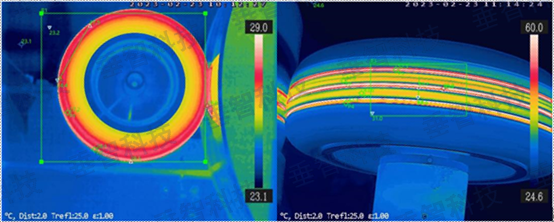

Background:
Infrared cameras are increasingly valuable in automotive braking systems, enhancing both safety and performance. These cameras monitor brake pad and system temperatures, which is crucial because temperature affects braking effectiveness and wear resistance. Excessive friction can raise brake disc and pad temperatures to extreme levels, impacting their performance.
Infrared devices have significant applications in automotive braking systems, primarily focusing on performance monitoring, safety assessment, and quality control. Here are some key applications:
Applications of Infrared Devices in Automotive Braking Systems
Infrared thermal imaging is used to monitor the temperature of brake discs during operation. By observing the temperature distribution across the brake disc, engineers can assess whether the braking system is functioning optimally. For instance, if the temperature of the front wheels is significantly higher than that of the rear wheels, it may indicate an imbalance in the braking system that requires further investigation
The efficiency of brake pads can be compromised if they overheat. Infrared cameras can detect excessive temperatures during braking, which can reach up to 1000°C under heavy braking conditions. By analyzing the thermal data, engineers can evaluate the performance and wear characteristics of brake pads, ensuring they do not degrade prematurely or fail during critical moments
Infrared thermography serves as a non-destructive testing method for brake components during manufacturing. By monitoring temperature variations, manufacturers can identify defects in materials or assembly processes that could affect brake performance. This proactive quality control helps ensure that all components meet safety and performance standards before being installed in vehicles
Infrared devices are also used to assess other components of the braking system, such as calipers and lines. By detecting heat patterns, engineers can identify issues such as fluid leaks or blockages that may not be visible through traditional inspection methods. This capability enhances overall system reliability and safety.
Effective thermal management is crucial for braking systems to prevent overheating and maintain performance. Infrared imaging helps analyze heat dissipation patterns in brake systems, allowing for design improvements that enhance cooling efficiency. This is particularly important in high-performance vehicles where braking systems are subjected to extreme conditions.
Benefits of Using Infrared Devices in Braking Systems
Real-Time Monitoring: Infrared technology provides immediate feedback on temperature changes, enabling quick adjustments to improve safety.
Enhanced Safety: Early detection of overheating or imbalances in the braking system reduces the risk of brake failure.
Non-Destructive Testing: Infrared thermography allows for thorough inspections without damaging components, ensuring quality control throughout manufacturing.
In summary, infrared devices play a vital role in enhancing the safety and performance of automotive braking systems by providing critical data for monitoring and analysis throughout the vehicle's lifecycle.

LASER Photonics China 2025: A new chapter of optoelectronic technology innovation and global cooperation From March 11 to 13, 2025, the most influential event in Asia's optoelectronics industry, LASER Photonics China, will be held in Shanghai New International Expo Center. As the flagship exhibition in China's laser, optics and optoe...